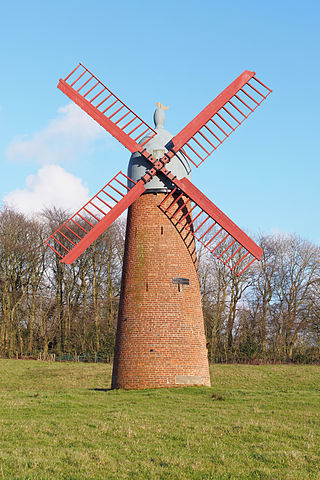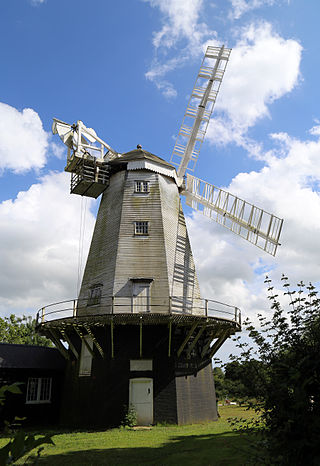
Stocks Mill is a Grade II* listed post mill in Wittersham on the Isle of Oxney, in Kent, England which has been preserved.

Maud Foster Windmill is a seven-storey, five sail windmill located by the Maud Foster Drain in Skirbeck, Boston, Lincolnshire, from which she is named. She is one of the largest operating windmills in England being 80 feet (24.38 m) tall to the cap ball.

A tower mill is a type of vertical windmill consisting of a brick or stone tower, on which sits a wooden 'cap' or roof, which can rotate to bring the sails into the wind.

King's Mill or Vincent's Mill, Shipley, West Sussex, England, is a smock mill built in 1879.

Denver Windmill is a Grade II* listed tower mill at Denver, Norfolk, England. In March 2010, there were about 374,000 list entries of which 5.5% were Grade II* and even fewer were superior.

Burnham Overy Staithe Windmill is a Grade II* listed building tower mill at Burnham Overy Staithe, Norfolk, England which has been converted to holiday accommodation.

Cley Windmill is a Grade II* listed tower mill at Cley next the Sea, Norfolk, England which has been converted to residential accommodation.

Union Mill is a Grade I listed smock mill in Cranbrook, Kent, England, which has been restored to working order. It is the tallest smock mill in the United Kingdom.

Herne Windmill is a Grade I listed smock mill in Herne, Kent, England, that was built in 1789.

West Kingsdown Windmill is a Grade II listed smock mill in West Kingsdown, Kent, England, that was built in the early nineteenth century at Farningham and moved to West Kingsdown in 1880. It is the survivor of a pair of windmills.

Draper's Windmill or Old Mill is a Grade II listed Smock mill in Margate, Kent, England that was built in 1845.

Ashby's Mill, often referred to as Brixton Windmill, is a restored grade II* listed tower mill at Brixton in the London Borough of Lambeth. The mill was in Surrey when built and has been preserved.

Crux Easton wind engine is a Grade II listed Titt wind engine, used as a windpump, at Crux Easton, Hampshire, England, which has been restored to working order.

Union Mills or Roy's Mills are a Grade II listed combined tower mill and watermill at Burnham Overy, Norfolk, England which has been converted to residential accommodation.
John Kenneth Major ARIBA, FSA, popularly known as Ken Major was an architect, author and world authority on industrial archaeology, particularly windmills, watermills and animal powered machines. As an author, he was known as J Kenneth Major.
















